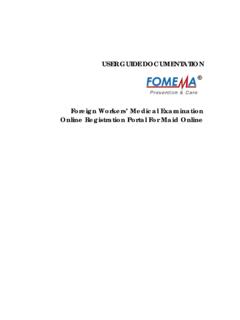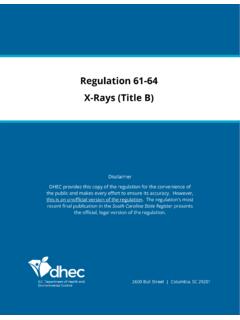Transcription of E-beam, X-ray and Ethylene Oxide Technologies for the ...
1 A Comparison of Gamma, E-beam, X-ray and Ethylene Oxide Technologies for the Industrial Sterilization of Medical Devices and Healthcare Products AUGUST 31, 2017. Page 1. FOREWORD. The purpose of this white paper is to discuss the role and importance of major industrial sterilization methods to the global healthcare industry. The paper discusses radiation-based (gamma, electron beam, X-ray ) and gas-based ( Ethylene Oxide ) sterilization processes and the regulations, controls and best practices associated with their safe and secure operations. By providing a holistic view of the sterilization marketplace, this paper provides a detailed review and comparison of the various Technologies in the provision of safe, fit-for-purpose, sterile medical devices and healthcare products to patients in the US.
2 And worldwide. This document is provided for informational purposes only and is believed to be accurate as of the date of its publication, and is subject to change without notice. ACKNOWLEDGEMENTS. This white paper was collaborated upon and written by a significant number of members of companies that constitute the Gamma Industry Processing Alliance (GIPA) and subsequently reviewed by the International Irradiation Association (iia). These authors and reviewers included members of global medical device and pharmaceutical companies. The experience of the participants spans many decades and incorporates practical, business use of all of the sterilization Technologies described and assessed in this document.
3 This white paper is being jointly published by GIPA and iia. Details about GIPA and its membership can be found at and about the iia and its membership at Trademarks and registered trademarks cited herein are the property of their respective owners. Page 2. TABLE OF CONTENTS. Section 1 Executive Summary .. 4. Section 2 Overview of the Medical Device Industry .. 6. Section 3 Gamma 10. Overview .. 10. Physical Description .. 10. Energy .. 12. Power .. 12. Conversion Efficiency and Throughput Estimates .. 13. Induced Radioactivity .. 13. Regulatory .. 13. Safety and Security .. 14. Environmental .. 16. Section 4 Electron Beam Technology.
4 17. Overview .. 17. Physical Description .. 17. Energy .. 19. Power .. 19. Conversion Efficiency, Throughput Estimates and Electricity Costs .. 20. Induced Radioactivity .. 20. Regulatory .. 20. Section 5 X-ray Technology .. 21. Overview .. 21. Physical Description .. 21. Energy .. 24. Power .. 25. Conversion Efficiency, Throughput Estimates and Electricity Costs .. 25. Induced Radioactivity .. 27. Regulatory .. 27. Section 6 Ethylene Oxide Technology .. 28. Overview .. 28. Physical Description .. 29. Regulatory .. 30. Safety .. 31. Environmental .. 32. Facility Throughput .. 32. Section 7 Modality Comparisons.
5 33. Suitability to Sterilization of Medical Devices .. 33. Equipment .. 36. Economics .. 39. Environment .. 44. Section 8 Summary & Conclusions .. 45. APPENDIX I ACRONYMS .. Error! Bookmark not defined. APPENDIX II REFERENCES .. 48 Page 3. Section 1. EXECUTIVE SUMMARY. Many manufactured products are critical to protecting, promoting and enhancing life, with healthcare products including devices and medicinal products being of considerable importance. The goal of this white paper is to describe the role and importance of industrial sterilization methods for the purpose of rendering single-use healthcare products safe and ready for their intended use.
6 This white paper does not cover the sterilization of reusable devices. This paper discusses the major sterilization modalities, including both radiation based (gamma, e-beam and X-ray ) and gas based ( Ethylene Oxide ) Technologies . These Technologies are compared and contrasted in significant detail to provide the reader with a greater understanding of the way they work and their capabilities. This paper further highlights the advantages of each technology and describes their disadvantages/considerations. There are other alternative modalities used for sterilization, but since their use is very limited they were not considered in this paper.
7 The medical device manufacturing industry is a highly diversified and mature sector that produces a wide range of products designed to diagnose and treat patients in healthcare systems worldwide. The aging population and a greater number of people, globally, having access to healthcare, is fueling innovation in the ongoing quest for better and more widely available ways of diagnosing and treating medical problems. As market demand and innovation increases, there will be a continued requirement for ever-increasing sterilization capacity, access to validated and approved sterilization methods, and availability of a suite of available sterilization modalities, since no single technology is ideal for all applications.
8 Sterilization is considered a processing step within the overall healthcare product manufacturing process. The sterilization modality selected for a product is based on a number of factors, including material compatibility, process availability, processing location, physical device attributes, legacy regulatory approval, processing volume, speed to market, cost and regulatory registration within the countries in which the medical device or products are to be distributed and utilized. Once selected, the process is validated, and approval obtained from the relevant regulatory authority ( , US Food and Drug Administration (FDA)) as part of the overall healthcare product manufacturing and utilization process.
9 Given the time, cost and effort to introduce a healthcare product to market, altering the sterilization modality can be costly and take many years. Hence, appropriate selection at the time of product design and registration is critical. Furthermore, healthcare markets, given the criticality and safety requirements of the products they require, which are used to save and extend patient lives and general public health are, by nature, risk averse. Moreover, the majority of medical device products supplied today from simple syringes to gowns and procedure packs to complex programmable pacemakers and artificial joints are iterations of products developed many years ago.
10 It is with these two key points in mind that the industry continues to see the ongoing need for the most traditional of modalities; namely, gamma radiation sterilization and Ethylene Oxide (EO) gas sterilization, while growing the involvement of Technologies such as e-beam and X-ray as an expansion of the sterilization modality suite. Page 4. The review and comparisons of the available sterilization Technologies contained in this paper should assist the reader in understanding the factors required in assessing their sterilization needs, as well as the details of the various sterilization modality capabilities in meeting those needs.







